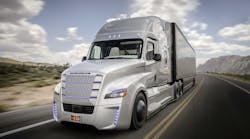A new report from Navigant Research predicts that both semi- and fully-autonomous driving systems can lead to significant reductions in fuel consumption and operating costs for commercial fleets.
According to the firm’s analysis, automated systems can reduce the number of accidents, use a more fuel efficient style of driving, and because they do not get distracted or need extended rest periods, operators can achieve higher levels of vehicle utilization, particularly in long haul applications.
“The pursuit of a fully automated driving car has spurred investment in advanced sensors and computing hardware and software,” noted David Alexander, Navigant’s senior analyst, in a statement.
“Lower cost and higher power are the keys to commercial success, and the technology is quickly approaching the threshold where it will be practical to bring advanced features to the mass market,” he added. “These systems are being rapidly adapted to the commercial vehicle market.”
According to Navigant’s study, those benefits could be the incentive for commercial fleets to implement driver assistance systems in the short term, which will pave the way for adoption of fully automated vehicles over the longer term – beginning in the next decade.
Freight-hauling trucks and buses can benefit in the short term from collision avoidance and lower fuel consumption, the firm noted, while automated driving systems could “potentially change significantly the nature of truck driving jobs.”



